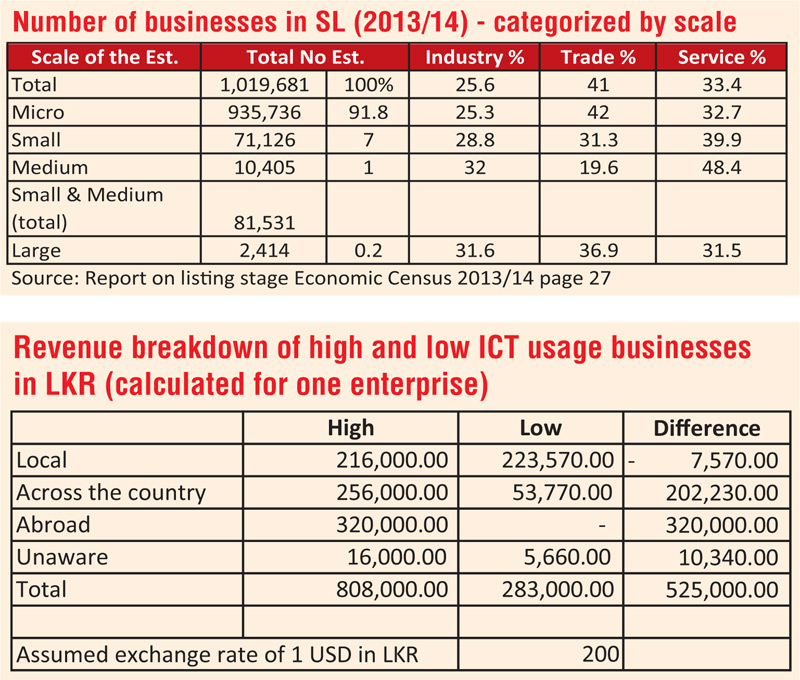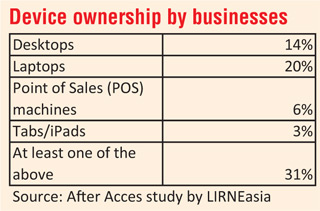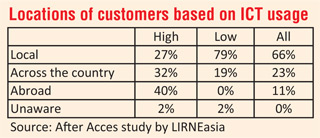Thursday Nov 20, 2025
Thursday Nov 20, 2025
Wednesday, 2 June 2021 00:00 - - {{hitsCtrl.values.hits}}

By Saminda Uswatta
 |
 |
 |
 |
While the recent (post-pandemic) performance of Sri Lankan exports has been quite positive, the country has found it challenging to increase its exports significantly and to diversify both its export basket and key export destinations.
Given especially that 3,000 Small and Medium Enterprises (SMEs) are said to be registered as exporters with the Export Development Board (EDB), strengthening these exporters could be critical in expanding and diversifying the country’s export base.
In that case, what could be that elusive silver bullet, that one single development, that could significantly strengthen our small and medium businesses (SMBs) to the point that they are capable of exporting?
High ICT usage ability could be the answer, according to a study done two years ago by the digital policy research think-tank, LIRNEasia. While this study was done pre-pandemic, its findings are perhaps even more relevant now and it is a document well-worth reading for anyone with interest in the subject.
The key finding of the study that would be relevant in this context is that while 40% of customers of SMBs with high ICT usage are located abroad (hence exports), for SMBs with low ICT usage, the share of foreign customers stands at zero.
This indicates that high ICT usage could be critical in transforming our SMBs who would otherwise be heavily dependent on their local market (SMBs with low ICT usage rely on their immediate vicinity for nearly 80% of sales, according to the study).
Of course, there are likely other contributing factors to the success of the SMBs with high ICT usage – perhaps factors such as higher proficiency in English (which would help in acquiring foreign customers/suppliers) and better business acumen, etc. However, the massive disparity in the share of foreign customers as a percentage of total customers indicates that high ICT usage ability would still likely be an essential factor to develop SMBs capable of exporting.
The findings of the study also allow estimation of the opportunity cost of poor ICT usage among SMBs by considering the disparity among earnings of SMBs with high and low levels of ICT usage. Using the data from the LIRNEasia study together with national data on the number of SMBs (provided in the National Policy Framework for SME Development) and by using few assumptions, one can estimate the opportunity cost at national level.
The key assumptions here are that the findings of the study are applicable at national level and that revenue earned from different customer groups by SMBs corresponds directly with the share of these customers in the customer base. It is also assumed that the US Dollar is equivalent to 200 Sri Lankan Rupees.
Calculated on this basis, low level of ICT usage by SMBs carries a very heavy opportunity cost.
If all SMBs with low levels of ICT usage were to transform to high ICT usage, this would add an additional $ 1.1 billion in annual export revenue to our national export earnings. To put this amount in perspective, Sri Lanka earned around $ 1.2 billion from tea exports in 2020. Hence, annual export earnings from tea is only a marginal $ 0.1 billion higher than what could have potentially been generated via high ICT usage by SMBs.
It should also be noted that Sri Lanka’s monthly export earnings are often around or below $ 1 billion. Hence, high ICT usage by SMBs could potentially add approximately an additional month of export earnings to the country’s national export earnings.
In total, with additional sales within Sri Lanka, if all SMBs with low levels of ICT usage were to convert to high levels, it would serve as an annual infusion of $ 1.8 billion to the country’s economy (without taking into account any potential multiplier effects and potential economic displacements). Of course, making such a conversion would be no easy task and it is unlikely that all SMBs would be capable of high levels of ICT usage. However, there are certain low-hanging fruits.
For instance, according to the LIRNEasia study 34% (or approximately one third) of SMBs who don’t use computers are constrained either by inability to purchase/afford a computer or lack of understanding to operate one. This implies that a sizeable component of SMBs could be interested in using computers, although they are currently unable to do so due to financial or knowledge constraints.
If that is so, developments such as the availability of small-business financing for SMBs to purchase computers and/or to train staff on using them could go a long way in both boosting SMBs and in expanding the country’s exports.